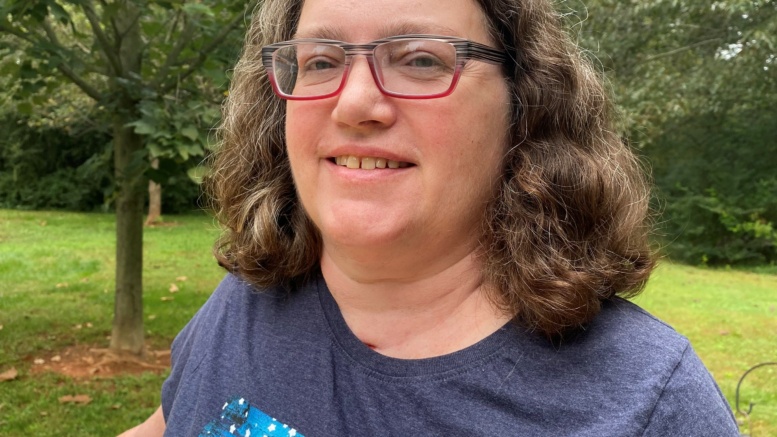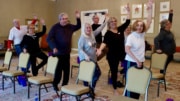Contributed.
On Tuesday, August 17, 2021, Seagrove resident Angela Hastings started to get a sore throat, fever and nausea. By Friday, her sore throat was so severe that she couldn’t swallow ibuprofen to help break her persistent high fever. A visit to her doctor confirmed what she didn’t want to hear – COVID-19.
The following Monday, Angela’s former pastor gave her a pulse oximeter for measuring her blood oxygen level. A normal blood oxygen measurement is 95% or higher, but Angela’s was 83%, indicating that her body wasn’t getting the oxygen it needed. Her husband, who also had COVID-19 but with milder symptoms, called EMS. Paramedics transported Angela to FirstHealth Moore Regional Hospital in Pinehurst.
Angela doesn’t remember much after arriving at the hospital. “I remember asking the Lord to take care of me,” she said. “I told my husband to not give up on me.”
Angela soon developed pneumonia, a condition that causes the lungs to fill with fluid and become inflamed. Doctors placed her on a ventilator to breathe for her and help keep her alive.
Statistics show that once patients with COVID-19 experience breathing difficulties so severe that they need a ventilator, their survival rate is low. “We were told she had only a 20% chance of making it off the ventilator,” said Angela’s daughter, Tabitha Gesme. “And if she did make it, she likely would not be herself.”
Jordanna Hostler, M.D., was one of Angela’s critical care physicians at Moore Regional. “I told Angela’s family that she had a very bad prognosis, but we were going to work together,” Dr. Hostler said. She connected Angela’s family with palliative care, a service that supports patients with life-limiting diseases and their families.
Establishing Angela’s Team
When developing a plan for critical care, Dr. Hostler often employs a concept called “shared decision making.” She presents the facts about a patient’s condition to the family, and they make health care decisions as a team.
Angela’s team decided that if her condition declined into respiratory arrest, they would not try to resuscitate her. “We decided not to try CPR or electrical shock because those treatments for patients as sick as Angela are usually futile and fatal,” said Dr. Hostler. “We were going to give her the best possible chance to survive but not hurt her in the process.”
Angela’s family embraced the team concept. “Angela’s family came into her treatment as a partnership with her health care providers,” Dr. Hostler said. “They listened and asked good questions. The positive attitude they brought to the situation really helped me do my job.”
Tabitha reciprocated the admiration. “Dr. Hostler was a godsend,” she said. “She constantly kept me informed on everything, and her plans were absolutely wonderful for Mom.”
Dr. Hostler set a daily goal for Angela’s improvement, such as a medication reduction that Angela could tolerate or less support from the breathing machine. Tabitha shared the daily goals with a larger, extended team – an army of Angela’s friends and family. “I’m telling you, I’ve never seen this many people praying for somebody,” Tabitha said. “Sometimes, it would take a couple of days to get what we prayed for, but not one single prayer was left unanswered.”
Keeping Her Care Team on Their Toes
One of the many components of Angela’s treatment was sedation medication so her body would remain still and start to heal. While these drugs were essential, Dr. Hostler told Angela’s family that the longer she was on the paralytic medication, the longer it would take to recover. Also, Angela needed to be off these medications before doctors could remove the ventilator.
Weaning Angela off the paralytic medications proved difficult, as it caused Angela to become anxious and agitated. “Mom kept the nurses on their toes,” Tabitha said.
After Angela’s body was awake, the next goal was tapering medications so her mind could be awake, a balance that took several days to find. “She needed to be sedated enough to not hurt herself but aware enough to participate in her own care,” said Dr. Hostler. Again, Angela’s extended team of prayer warriors got to work.
A next step was removing Angela from the ventilator – a procedure carefully executed through trial and error. Dr. Hostler reduced Angela’s breathing machine support to see how she fared. Angela improved, so Dr. Hostler maintained the course. She kept Angela’s family informed at each step.
Angela’s health care team attempted to remove the ventilator on September 13, but soon after, her throat became swollen and closed. She required a tracheostomy, a surgical opening in the front of the neck so doctors could insert a tube into her trachea (windpipe) to help her breathe. Doctors put her back on the ventilator through the tracheostomy. Dr. Hostler told Angela’s family the opening in her neck wasn’t permanent but would help her recover faster.
Doctors also inserted a percutaneous endoscopic gastrostomy (PEG or feeding) tube for Angela’s nutrition.
“A Miracle”
On September 17, one month after Angela started feeling ill, doctors removed her ventilator. Tabitha called it a miracle.
At this point, another team with new goals got to work on Angela – a multispecialty group of FirstHealth physical therapists to strengthen her body, occupational therapists to assist with everyday tasks and speech-language pathologists to help her talk and swallow.
“Once Angela woke up and I got to know her, I realized that she is just another part of her amazing family,” Dr. Hostler said. “She worked hard and did everything that was asked of her to actively participate in her rehabilitation.”
In addition to Dr. Hostler and the therapists, Tabitha credits the nurses for their help, notably Dory Franklin, R.N., BSN, CBN. “Dory helped me throughout Mom’s care, particularly with research and helping me find more information about what we were going through,” Tabitha said.
Angela’s army of friends and family continued their work outside the hospital walls.
Angela continued improving and wanted to walk around – uncommon among patients with COVID-19, especially after only four weeks in the hospital. She transferred to a rehabilitation hospital in Greensboro. The original plan was to stay there for four weeks, but she surpassed all goals and was out in eight days.
Angela returned home on October 5 and is recuperating well, reporting only a few headaches. On October 20, just eight weeks after her first COVID-19 symptoms, she walked with her husband to the end of their 485-foot driveway.
The Importance of Vaccination and Testing: “COVID-19 is No Joke.”
Before getting COVID-19, Angela had not received the vaccine, but she reported she will soon. “COVID-19 is no joke,” she said. “It’s real, and I wish people would be more cautious about it,” she said.
The mother of four and grandmother of seven also stressed the need for COVID-19 testing. “If people think they might have COVID-19, they really need to get tested, so they don’t spread it,” she said.
Angela hopes to return to her administrative job at a foundry in Biscoe by the end of the year. She also wants to get back to fishing, camping, gardening, crocheting and playing with the grandkids.
“All of us in Mom’s army prayed that God would bring Mom out of this and give us more time with her,” Tabitha said, adding that she also hoped her mother could be mobile. “Now, as I see her moving around, it’s almost like she never went through this. She is an absolute miracle.”
###
NAMELINE: Angela Hastings, one week after being released from Moore Regional Hospital following a long battle with COVID-19.










